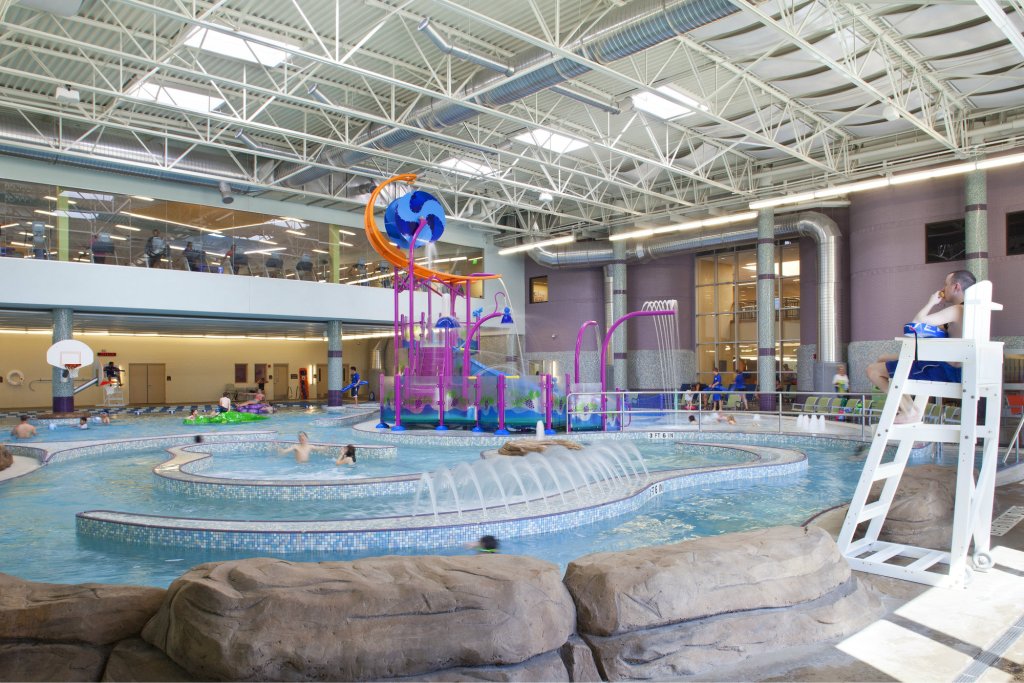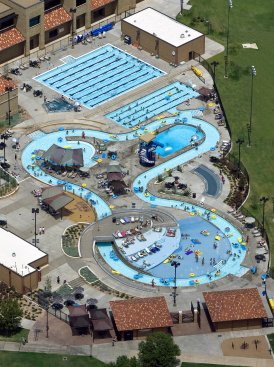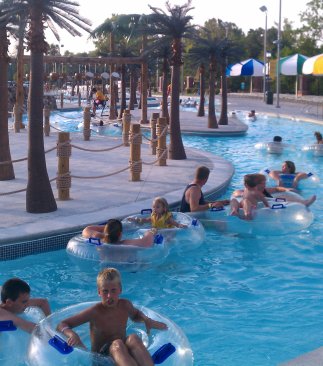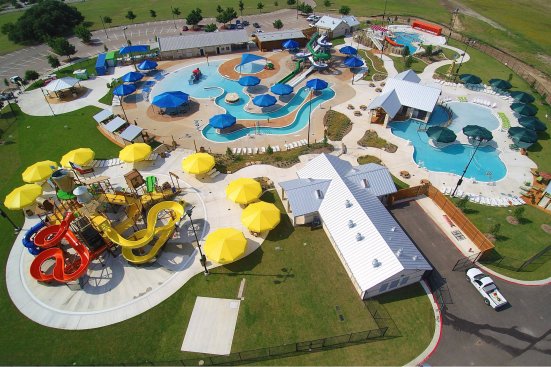Aquatics designers say that lazy rivers remain one of the most-requested new features among facilities.
Courtesy Sunbelt Pools
There are plenty of reasons. Aesthetically, they enhance and invite theming, especially when combined with other features or bridges. They tie together some or all the areas in an aquatic environment simply by veering from one to the next, or going around them.
Lazy rivers also hold a lot of people and have a magnetic appeal, so they can function as a hub serving several programming purposes. “It’s one of the most popular capacity holders,” says Kevin Post, principal and director of aquatic operations for Counsilman-Hunsaker, an aquatics firm based in St. Louis. “It’s a great area to start as the foundation of any design.”
Here, experts discuss the considerations that go with adding a lazy river to a facility.
THE OPTIONS
Lazy rivers are known mostly for introducing a laid-back vibe to a property. Long, wide and meandering, they can nicely balance out faster or more aggressive features such as wave pools.
“If you’re looking for something that isn’t as high-energy … but you want capacity for it, a lazy river is very appropriate in the entertainment or recreation environment,” says Matthew Freeby, a project leader for Water Technology Inc. in Beaver Dam, Wis..
They can connect with other features to extend the fun. For instance, designers may attach the river to a slide plunge. When somebody exits the slide, they can enter the river and take a ride.
But not all lazy rivers are alike. Gauging their appropriateness and design requires the consideration of several factors. The list begins with available space, particularly for indoor facilities.
In their traditional, meandering form, lazy rivers generally occupy more space than traditional pools, even if they have the same square footage of surface area. This becomes particularly challenging indoors. However that doesn’t mean this feature should be ruled out in tight applications. The object simply becomes to gain as much use in as little space as possible. And designers have many creative options available.
“Obviously, if you don’t have space for it, you don’t have space for it,” Freeby says. “But if you’re meeting a program need, you can usually find space.”
The river may take a shorter run, bend on itself, tightly snake around another planned zone or pool, or even run under an elevated feature or deck. But it can take different forms, too, such as shorter, narrower versions called current channels. Where lazy rivers generally range in width from 12 to 15 feet, current channels hover at about 6 to 8 feet. Even shorter, narrower, shallower versions called tot rivers accommodate little ones in life jackets.
The configuration and size will impact the feature’s mood and usage. Outdoors and in more vast spaces, lazy rivers can serve as a strictly recreational spot, where people take their rafts and leisurely cruise. But in tighter areas — particularly indoors — operators must squeeze as much use as possible from every square foot, so lazy rivers or current channels will be used to expand programming. The current can provide resistance training to athletes who swim or run against it, or for us mortals who just walk. With the current turned off, the area can accommodate water aerobics and other group courses. Freeby has even seen these features used by local fire departments to practice river rescues.
The intended use will affect depth. A lazy river meant strictly for rafts can go as shallow as 2 or 2½ feet. However, they’ll need 3½ to 4 feet to adequately submerse walkers, runners and aerobics classes, Post says. Even if a river doesn’t augment programming, he prefers 3½ to 4-foot depths so people can comfortably dangle their feet from their floating devices. But some operators want shallower water to save on construction and operation costs.
Programming can affect configuration. To hold swim lessons, for example, a river or channel generally needs at least one fairly long, straight run. Stairs at the beginning and end of this area can provide visual markers for the space, along with access and egress.
Placement of the river or channel can provide options for water aerobics and other courses. For instance, if it connects to a pool’s shallow end, a class can move back and forth between the two for a change of scenery, Post says.
ON GUARD
Staffing issues can guide some design choices for a channel or river.
The number of bends will greatly impact how many lifeguards are needed. Curves hamper visibility so, generally speaking, Post suggests that at least one guard man each curve. Additionally, anytime the river goes under a deck or bridge, that poses another visual obstruction, which may require another guard, Freeby says.
Sprawled out rivers may take long and loose runs — maybe even some straighter stretches that afford more visibility to a single guard. But in restricted spaces, the tighter, space-saving coiling will create added blind spots.
In addition to collectively scanning every square inch of river, rescuers must be positioned within 20 second’s reach of any person in distress, reminds Michael Oostman, president of Oostman Aquatic Safety Consulting in North Reading, Mass. So physical, as well as visual, obstructions must be considered. More lifeguards also will be required for higher capacities.
If anything dissuades one of Post’s clients from incorporating a lazy river, it is usually the cost of added lifeguards.
“However, lazy rivers are one of the most popular amenities,” he says. “So while there’s a cost, there’s also a revenue associated with it. We’ve found that if you’re willing to charge the appropriate amount and [implement] the marketing to get the attendance you need, the revenue can offset that increase in expenses.”
To minimize the number of needed guards, the rivers can be designed more like the aquatics version of a running track, simply going down one side of a feature or area and back the other.
Regardless of configuration, lifeguards may need special training to watch people who typical are moving 1 to 3 miles per hour. “If you’re guarding a [still-water] pool and doing your scan, when you return to a location, it is likely the people will be in roughly the same location,” Freeby says. “In a river, they won’t be.”
For this reason, facilities often place guards downstream of their coverage zone. “I want someone coming towards me if I have to react to them, not going away,” Freeby says.
Additionally, guards must become acquainted with where the water moves faster due to jet placement or narrowing of the channel, Oostman says. They also must know the best spots for extrication, which can pose challenging in moving water. Emergency shut-offs can be placed, but it takes a while for the water to stop.
While these issues provide food for thought, lifeguard positioning on a lazy river or current channel should always be analyzed on an individual basis by staffing and operations experts.
Safety affects design in other ways. For instance, the team must decide how people can access the river. It can be tough to board a device in moving water, so designers like to include at least one zero-depth-entry area or other alcove-type space removed from the current. The zero-depth-entry or ramp option also provides disability access. Otherwise, you may need a lift.
To help people self-correct, Freeby recommends a built-in hand grip. “If somebody becomes dislodged from their tube and needs to stand up, you want the wall of the river low enough that someone could grab onto it if they need help stabilizing themselves.”
While lazy rivers often invite tropical or other outdoorsy themes, rocks and other features should not protrude into the moving water, lest somebody bump their head. Bridges should have an 8-foot clearance from the channel’s bottom so nobody can stand up and hit their heads, Freeby says. If there’s any reason to expect people to jump, that clearance should rise to 9 or 10 feet.
OTHER CONSIDERATIONS
Lazy rivers don’t pose much difference from a regular pool in terms of maintenance — there’s just more of everything.
Often, rivers run on dedicated pumps, separate from the filtration system. This becomes necessary for operators who want to periodically turn the water off for programming. If operators plan to keep the river running at all times, the filtration perhaps can be plumbed with the river system.
These features add equipment that must be maintained and add electrical load to operate the powerful pumps. The moving water will mean higher evaporation and heat loss compared with still bodies. Because they’re so popular, these features can exponentially increase the burden on the water’s sanitation system. And higher turnover rates will require larger filters.
The interior finish also can be important, especially when the feature serves multiple purposes and audiences. In these cases, the surface should provide enough traction for resistance walkers or water aerobics students, yet be too smooth to scrape those who brush against it, Freeby says.




